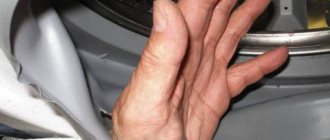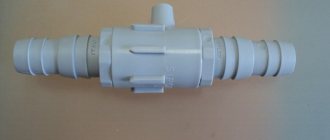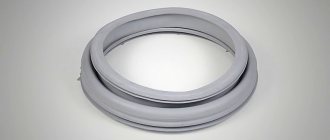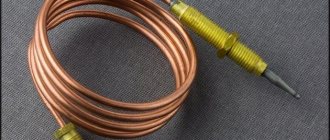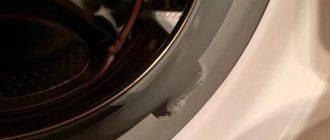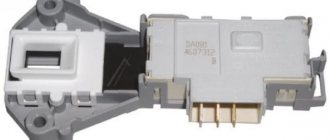Suspicions that the cuff for a washing machine has become unusable arise when water drips from under the door of a working unit. If the cause of the leak is indeed a violation of the integrity of the rubber gasket, do not be too upset. If desired, the tightness of the tank can be restored independently.
We will tell you how to replace this important type of seal yourself, which ensures the tightness of a tank filled with water during washing. In our article, the process of removing and installing a new cuff is described step by step. Our advice will help you achieve an impeccable result.
What is a cuff?
The main purpose of the rubber part installed on the hatch of an automatic washing machine is to hermetically seal the loading tank during operation of the machine. This layer does not allow even a drop of water to seep out.
The location of the cuff and its appearance completely depends on the model of the machine. If loading is frontal, a rubber layer connects the tank to the front wall of the unit and has a round shape. In models with vertical loading of laundry, the part combines the tank with the upper wall and has the shape of a rectangle.
Without a door seal for loading laundry, the machine door cannot be closed tightly. The special composition of rubber or silicone from which the part is made ensures complete sealing of the tank during washing
Previously, seals were made of very flexible rubber. In modern models, cuffs are almost always installed from a similar material of artificial origin - silicone. It does not lose its elastic properties over a wide temperature range and does not “tan” over time.
Cuffs of different models differ in size and shape. If the washing machine has additional functions, for example, drying and aquaspray, the part may have additional holes.
Examples of current positions
It is worth noting that a huge number of cuffs are universal, since the hole for the door is most often unified. The dimensions of the drum, including the format of the washing machine, are realized through the internal volume with the transfer of the load point and shock-absorbing ligament below or above the non-removable part of the device body. Therefore, the following universal and original (for a whole series of devices) rubber seals are popular:
- GSK007WH, 481246668775 (for the Whirpool line, consisting of more than 100 models) – 420 rubles .
- INDESIT 0262267, GSK012ID (with clamp and clamp) – 440 RUR .
- ARDO 4001000 (suitable for many washing machines with a load of 5 kg and an additional drain channel in the elastic band) – 950 rub .
- Universal for Indesit/Ariston 103633, GSK002ID, IT3004, AF546TIT – 600 rub .
- Whirlpool 481010410453 (for all vertical washing machines of this manufacturer) – RUB 3,350 .
- BOSCH/SIEMENS 8kg, 680405, 478300, 478322, 681211 (with lamp outlet) – 4,000 rub.
- Zanussi 1327756100 – 3,874 rub .
What are the reasons for wear of a part?
There are not many reasons why the cuff stops performing its functions. Moreover, most of them occur when the rules for using household appliances are not followed.
The main ones are the following:
- mechanical damage from rough objects;
- strong vibration of the drum during spinning;
- exposure to aggressive agents;
- mold on rubber;
- inaccurate loading of dirty items or removal of already washed items;
- natural wear and tear.
Damage from objects occurs when rough items are often washed in the machine, for example, sneakers, outerwear with hard “snakes,” etc. Metal products (nails, keys) and plastic that have fallen into the drum due to user carelessness can also cause the formation of significant defects on the rubber.
Cracks, cuts and tears in the rubber part can appear either as a result of a malfunction of the washing unit or due to the carelessness of users. Before loading clothes into the machine, be sure to check pockets for rough or sharp objects. They can easily damage the cuff
The washing machine drum tends to vibrate strongly if the machine is not installed correctly. Accordingly, the cuff attached to it suffers. The use of bleaching agents frequently and in high concentrations causes the rubber to become rougher. And the loss of elasticity, as is known, is fraught with the rapid appearance of defects.
The acids and alkalis used to clean the machine act in the same way. But again, if they are used incorrectly. For example, some users believe that the higher the concentration of the product, the more effective the cleaning. At the same time, they do not take into account the aggressive influence on the parts available for processing.
Mold is microscopic fungi that live in colonies. Having settled on soft rubber, the mycelium of these tiny creatures is able to germinate deeply. If the damage is severe, dark gray spots that emit an unpleasant odor cannot be removed with anything. In this situation, only replacing the cuff with a new one will save you.
The washing machine does not last forever. Even if you handle it very carefully, the parts gradually wear out. The rubber seal is no exception. It constantly experiences friction from the rotating drum of the washing machine and laundry, temperature changes, and exposure to detergents. All these factors make rubber brittle and brittle over time.
How to extend the life of a washing machine?
It's better to prevent problems than to solve them
Sometimes, as a result of improper operation, not only the cuff, but also other parts of the unit deteriorate prematurely, so you must follow the tips to prevent such consequences:
- Each device is designed only for a certain weight of laundry, so you should not overload the drum. This provokes vibrations that lead to breakdowns.
- It is necessary to periodically run a “idle” wash using disinfectants. This will remove dirt and mildew from the cuff.
The device should be periodically cleaned of dirt, both from the outside and from the inside.
- You should not use too much detergent during washing, because their concentration leads to damage to parts.
- It is recommended to wash clothes no more than three times in 7 days. Otherwise, this will lead to premature wear of the elements.
- Do not install the washing machine in places where there is excessive humidity.
The washing machine components should be handled with care to avoid damage.
Another weak point in washing machines is the bearing. For reference, we recommend an article on this topic - How to change a bearing on a washing machine.
Prices for heating elements for a washing machine
Heating element for washing machine
How to properly replace?
First you need to check the condition of the cuff. To thoroughly inspect the seal for damage, it must be almost completely removed from the machine. To do this, simply remove the clamp that holds the part of the cuff that is attached to the front wall.
After the inspection, a decision may be made to replace the rubber band with a new one or to repair the existing one. Consider instructions for step-by-step cuff replacement.
Step #1 - remove the front clamp
The clamp is attached to the front wall in different ways for different models. It all depends on the material used to make the part.
There are 3 options:
- using latches;
- spring tension;
- screw fastening.
The first method is used for plastic clamps, the rest for metal ones. In any case, you will need a flat-head screwdriver to remove the part.
On most models, in order to pull the cuff towards you for inspection, it is enough to remove the clamp holding the curved part of the elastic in the front groove. By slightly moving the edge of the cuff, you can always determine whether it is plastic or metal
Then they act depending on the fastening: the screw is unscrewed, the spring is pulled back and weakened, and the plastic clamp is pulled towards itself in the place where the latches meet. After this, using the same screwdriver, removing the clamp will not be difficult.
However, not all so simple. Some companies produce models of washing units in which dismantling the “elastic band” requires necessarily removing the front wall.
These include:
- Samsung;
- Beko;
- Siemens;
- LG;
- Bosch;
- Hansa.
It is quite difficult to perform this manipulation on your own, but it is possible if you wish. The main thing is to act very carefully to avoid damage to the wires and contacts connected to the lock located on the wall.
Step #2 - remove the front panel
The first thing you absolutely need to do is disconnect the device from the power supply and make sure that there is no water in the drum and sump. Only after these steps can you proceed directly to removing the front panel.
To get to the screw holding the wall at the top, you should remove the powder receptacle. For this purpose, pull out the tray all the way, press the locking key inside and remove it from the machine.
In most models of washing machines, the powder container has a so-called “tab” located above the conditioner filling compartment. This powder receptacle can be removed without any problems. You need to simultaneously press the button and pull the tray towards you
Now you need to open and disconnect the hatch located at the bottom of the front wall of the machine. To do this, use a screwdriver to unscrew the fixing screw of the base panel, move it to the right until it clicks and move it toward you.
Next, open the hatch door and remove the clamp securing the cuff to the front panel. This is done by prying up the tension spring with a slotted screwdriver and removing it together with the clamp from the groove of the rubber seal.
Afterwards, the edge of the cuff is pulled out of the recess in a circle, the elastic is “sinked” into the body and the hatch door is latched. All the above actions provide access to the lower and upper screws. They are unscrewed, after which the panel is moved a few centimeters forward and carefully separated from the body.
Holding the front wall suspended, disconnect the plastic wire fastenings from it, and then the hatch locking contacts. Now you can safely put the front panel of the machine aside, remove the clamp and begin examining the cuff by pulling its front part towards you.
Step #3 - pull out the working cuff
After removing the front clamp (how to do this was discussed above), the rubber seal is completely removed.
It is necessary to remove the old cuff both in case of replacing the old cuff with a new one, and if minor repairs of this part are necessary
Proceed as follows:
- Carefully pull out the front part of the rubber seal, which is held on the machine body, due to its own tension.
- Find the mounting mark. It is located on the cuff itself.
- Using a marker, mark the response mark on the tank.
- Remove the second clamp in the same way as the first.
After the work is done, the cuff can be easily removed from the machine. The part just needs to be pulled well towards you.
Step #4 - inspect the rubber seal
At this stage, you will carefully examine the removed elastic band from all sides, paying special attention to the places on the folds. If, after examination, cuts, holes, cracks and other damage are detected on the cuff, it is advisable to replace the part with a new one.
The replacement cuff must match the machine model exactly. Otherwise, the seal may not fit, and all the work will go down the drain.
When selecting a new part, you should keep in mind that you cannot purchase rubber bands from other models of washing machines, even if they have significant similarities in appearance. Only a cuff designed for a specific brand of unit can be absolutely suitable. Only a master can select analogues and only in a hopeless situation.
Step #5 - prepare the installation site
When the cuff requires replacement, as is clearly evidenced by cracks and other damage, you can safely begin installing a new “elastic band”. The preparatory step before installing a new cuff is to thoroughly clean the edge of the tank. Typically, dirt and detergent residues accumulate in this place.
In order to clean the area of upcoming installation, a saturated soap solution is ideal. Alternatively, you can simply soap the sponge heavily.
It is better to clean the edge with a sponge, moistening it generously in a soap solution. In this case, there is no need to wash off the remaining foam and wipe the part dry. The soap will serve as a kind of lubricant and will help you complete the installation faster.
Step #6 - install a new cuff
Putting a new seal on the tank is not entirely easy. The material is difficult to stretch very much, and besides, it “exerts resistance”, stubbornly refusing to fall into place.
The first step is to apply the cuff to the upper edge of the tank so that the mounting marks coincide. Next, sliding the thumbs of both hands over the rubber, pull the seal onto the edge.
Movements when putting on an elastic band proceed from the center to the sides. It is important to show patience and maximum accuracy here.
At the next stage, soapy lubricant comes to the rescue. The cuff is stretched at the bottom and is quite difficult to put in place. Therefore, here the seal is forced onto the tank. After these manipulations, the “elastic band” is held tightly on the edge.
The last point is to check that the part is installed correctly. If the cuff does not adhere tightly to the metal in some places, leaks will occur while the machine is running.
Step #7 - tighten the inner clamp
Installation methods for internal clamps vary depending on the mounting. If the tension is spring-loaded, then installation is carried out using a screwdriver. The tool is inserted into the hatch blocking hole and a spring is put on it. Thus, the fastening stretches freely and the clamp is easily put on in the right place.
Clamps removed from the cuff can be put back in place only if everything was done without damage. If defects appear on the parts, they need to be thrown away and new ones purchased instead.
If you have a clamp with a screw, the task is somewhat simplified. The tension is almost completely unscrewed, and the clamp is placed in its seat. To strengthen the part, all that remains is to tighten the screw back.
If the washing machine is equipped with a wire clamp without tensioners, round nose pliers are used as an auxiliary tool. They carefully tighten the metal ends, and the resulting knot is hidden in the recess on the cuff provided for this purpose.
The easiest way is to put on a plastic clamp. It is secured using special latches. After the work has been done, the cuff is pulled onto the edge of the front panel of the machine and also secured with a clamp.
Finally, check the seal for leaks. To do this, start the fastest washing program. If no leaks are observed during operation of the unit, the cuff is installed correctly.
What will be needed when replacing
First of all, you need to choose the right cuff to replace. Always focus on the make and model of your SMA and, in accordance with this, choose tires. There is no need to buy a similar product; you only need to choose the original one for a specific washing machine model.
Also, don't forget to purchase clamps if yours get damaged or need replacing. Some SMs have metal clamps, others have plastic ones. The latter are much cheaper.
Now you can prepare the tool. You will need:
- flat screwdriver;
- pliers;
- soap solution;
- sandpaper.
Subtleties of cuff repair
Sometimes situations arise when the “elastic band” located on the hatch of the washing machine breaks, and it is not yet possible to replace the cuff.
When might repairs be needed?
For example, at the moment it is impossible to find a part suitable for the existing car model, or it is on order, and delivery will take a long time.
There are also circumstances when right now it is impossible to allocate money from the family budget to purchase a new part. In such situations, repairing the cuff, that is, sealing the damage site, will help out.
High temperature, detergents and constant friction of the laundry will soon take their toll, and the hole in the cuff will make itself felt again
Please note that gluing the patch is a temporary measure. Therefore, you need to try to replace the worn seal with a new one as quickly as possible.
How to select and prepare a cuff?
First of all, you need to inspect the leaky cuff and determine the cause of the damage. This is the only way to find out whether it is advisable to repair the seal or whether there is no point in it. To do this, you will have to remove the cuff from the machine using the method described above.
Only by removing the front clamp and pulling the cuff towards you can you detect damage, assess its size and the possibility of repair
If the cut, puncture or abrasion is small, then repair definitely makes sense. And when the damage is large or there are several of them, it is better not to rush with sealing.
After determining the cause of the repair, the material for the patch should be selected. It must be durable and at the same time elastic. Some experts recommend using condoms or medical rubber gloves for this purpose.
A great option is special patches designed for repairing swimming air mattresses. You can find them in sports stores.
The glue planned for use must have excellent adhesive properties. In this case, the substance must remain elastic after complete drying. This is exactly how products intended for repairing shoes and rubber products behave.
Instructions for sealing the seal
Sealing a rubber seal is a task that does not require special knowledge and skills. However, to ensure that the result does not disappoint, it is better to strictly follow the instructions.
We offer the first repair method - gluing . It is performed according to the following scheme:
- They are preparing a patch . Pieces of the selected material are folded into several layers and glued together. The size of the patch should be 1.5-2 times larger than the defect itself.
- The damaged area and the area around it are degreased . To do this, use alcohol, acetone, white spirit, etc. Wait until the degreaser dries completely.
- Glue is applied to the cuff and patch .
- The lubricated surfaces are pressed against each other either immediately or after a few minutes - this depends on the instructions on the tube of glue.
- The cuff is fixed in its natural position using suitable objects. So the part is left for a day.
After the glue has completely dried, the seal can be reinstalled.
The repaired cuff should be returned to its place using the same method as putting on a new one. Since the rubber is already stretched, you won’t have to put in as much effort as if you were installing a new part.
There is a second method, which is considered more reliable. It combines stitching and gluing.
The method is performed as follows:
- The damage is stitched end-to-end with a thick synthetic thread. In this case, a football seam is used.
- Afterwards, everything is generously impregnated with silicone sealant for rubber and plastic.
Next, as in the previous method, the cuff is left in its natural position for a day, after which it is installed back into the machine body.
After the repair has been completed, you must check the quality of the work. To do this, load the drum with laundry and start the wash on the shortest program. At the end of the cycle, the gluing site is inspected to identify repeated ruptures.
You can change not only the cuff that hermetically seals the hatch of the front washing machine with your own hands. Home craftsmen are quite capable of replacing the washing machine belt. Step-by-step instructions for carrying out this work are described in detail in the article we recommend.
Types of cuff and its purpose
The type of cuff is determined by the design of the automatic washing machine. If we are talking about vertical loading, and the splash protection option is provided, the element does not come into constant contact with water.
Tightness plays an important role in the case of spinning, because water simply cannot fly away in different directions under pressure. In such machines, the cuff is a guide for water drainage, and the tightness is ensured solely by the lid.
The remaining details depend on the design features of the tank. If the body part is a water container, a cuff of increased flexibility is not required. If the tank acts as an independent element and is suspended on shock absorbers, the cuff is attached to the frame and the tank at the same time. In this case, it is possible to provide a sealed sleeve that does not allow water to pass through in the joint area.
If the design of the machine provides for a front-loading type, the cuff is assigned a more important role. Along with providing protection against splashes, it holds the water mass while filling the container. The sleeve is constantly in contact with the liquid, and the load is uneven. The upper area is washed by splashes and waves during the operation of the drum. The lower area is almost always filled with water, which in turn can be cold or hot.
To ensure constant and tight contact with the hatch, it is necessary to ensure that the material has optimal performance parameters. To solve these problems, modern manufacturers are forced to seek a compromise.
On the one hand, they provide an increased level of product strength. On the other hand, the absence of hardening of the material due to temperature changes and the influence of aggressive detergent compositions plays a role. An important role is played by the compliance of the cuff with hygiene standards.
Repair of sealing rubber if it is impossible to replace it
In a situation where there is no spare part necessary for replacement, a temporary solution is allowed - installing a patch on the old rubber band of the washing machine drum or moving the seal so that the place of the break is at the highest point.
In the first case, repairs depend on the amount of damage:
- if there is a puncture or small tear with a diameter of 3-4 mm, then a patch is applied to the outside of the elastic;
- if the tear is larger, patches are applied on both sides.
The patching technology is carried out as follows:
- It is recommended to use repair kits for repairing wet rubber bicycle tires as a patch.
- The patch area is cleaned of dirt and wiped with alcohol, acetone or nail polish remover.
- The protective film is removed from the patch.
- The patch and its installation site are lubricated with glue.
- After 2-3 minutes, the patch is pressed tightly to the site of the break and fixed for 12-24 hours.
- If patches are installed on both sides, it is recommended to glue each side separately - this will increase the repair period, but will improve its quality.
- After drying, excess glue is carefully removed with a knife.
In the event of a small tear, when it is not possible to install a patch, the rubber seal of the loading hatch can simply be turned over. To do this, you need to disassemble the machine, remove the clamps or loosen them and carefully move the place of the break so that the hole is at the highest point. As an option, it is possible to install a metal clamp and clamp the hole from the outside. You can also stick a wide adhesive plaster on the outside - it won’t last long, but it will be enough for 2-3 washes until a new seal is found.
Non-standard connection
Some houses still have cast iron sewers. Typically, a reduction of 72*50 mm is used to connect the elbow to the tee. The parts to be joined must be dry and clean, the inside of the cast iron socket is lubricated with sealant, then the cuff and plastic adapter are inserted.
If the seal rubber is old, hard, and does not fit into the pipe, you should leave it for 20 minutes. in hot water to soften, it will easily fit into the desired hole.
Connecting a drain to a cast iron sewer in the video:
After successfully connecting the washing machine hose, you should connect the corrugation from the siphon. It is enough to insert it into the free hole of the tee, wrapping it with fum tape. Corrugation is usually produced with a diameter of no more than 40 mm, but there are rare exceptions. If it does not fit into the drain hole, make a careful cut at the end to slightly compress the edge. This must be done without zeal - fragile plastic easily cracks, and the siphon will have to be replaced.
After installing the washing machine, it is better to check all connections: run the machine without laundry and drain the water. If under the pressure of water the hose does not fly out of the rubber band, there are no drops or streams of water, then the installation was successful. You should also check the connection of the siphon corrugation.
conclusions
- The drain cuff is a gasket between the sewer pipe and the SMA drain hose.
- It comes in different sizes; for a standard connection you should choose 50*20 mm.
- Before purchasing a tee and reducer, measure the diameter of the pipes with a ruler.
- Installation does not always go smoothly; with a non-standard pipeline, parts are selected to the required size.
- It is better not to connect the drain hose to the siphon glass through a pipe - this may result in flooding of neighbors or breakdown of the car.
- To avoid leaks, you can use a special sealant.
- If over time the gasket loses its elasticity, the structure is disassembled and the cuff is replaced.
What materials are the cuffs made from?
When removed, the cuff is a sleeve, which is characterized by a cylinder or rectangle shape. Everything depends solely on the design of the loading hatch and the type of device, which can be vertical or frontal. Certain features apply to products that have a clothes drying mode. An outlet is provided in the area of the working wall.
As for the ends, they have clamping-type sides, which are characterized by a complex shape. It is due to them that the product fits as tightly as possible to the flanges of the body and tank. The fastening itself is very tight, but when heated, the material has the ability to expand. Therefore, to ensure increased reliability, the sides are fixed using clamps or springs.
A similar type of tie is used in the case of a rectangular cuff. The exception is a design in which the bottom hangs completely into a container attached to the body part. The material used in production is classic: it is rubber with an impressive rubber content. As for vulcanization, this process is carried out in a special way in order to maintain maximum softness and elasticity. Along with this, the mixture contains additives that provide the cuff with protection from tanning during prolonged exposure to liquid.
Installing a new rubber band
Installing the cuff is one of the most critical stages of repair, since it is necessary to maintain a tight fit and tightness. The step-by-step algorithm of actions is as follows:
- unpack the clamps and set aside the inner and outer ones separately;
- use the markings to position the cuff in the correct position. In most models, the triangle corresponds to the top of the seal, and the bottom has a hole for the hose;
- insert the rubber onto the tank in strict accordance with the markings, insert it into the drum;
- unscrew the two screws and remove the locking lock;
- insert the tip of the screwdriver into the lock, this will help fix the clamp motionless;
- install the inner clamp;
- put the lock in place;
- spread the rubber along the outer circumference of the body;
- use a soap solution to treat the surface and joint area;
- install the outer clamp and install the door in place.
Try closing the hatch, and if it comes out without force, then you have installed the sealing collar correctly. To check the tightness and tightness of the fit, run a test washing program. The rubber is installed tightly if there is no leakage.
It is better to entrust the repair of washing machines to professionals!!!
We present to you our unique catalog of private craftsmen and service centers —
Select your city and artist in the filter: by rating, reviews, price!
Prevention
As preventive procedures to preserve the quality of the hatch cuff of a washing machine, experts strongly recommend using only certified washing powders and additives specifically for machine washing. They do not affect the rubber gaskets in any way.
You should also pay attention to hard and small parts of clothing. It is recommended to wrap the buttons inside, that is, wash the clothes inside out. Be sure to check your pockets for extra items. And finally, you should remember about the natural wear and tear of the rubber band, since it does not last forever. It is worth monitoring its condition and calling a repair specialist if there is the slightest problem.
Rules for choosing a new cuff
In order for the cuff to be connected correctly and reliably, it is not enough to simply buy and install it: you will need the right approach to choosing a device. Several parameters should be taken into account:
- first you need to determine the diametrical cross-section of the pipe - outside and inside, so that the seal fits well to the walls;
- You should buy a product whose elastic band is as dense as possible so that it tightly grips the pipe; only with this approach can reliable fixation be ensured, especially in conditions of draining water and spinning things.
If the cuff is purchased separately from the tee (and they are usually sold as a set), you will need to follow similar rules. The main thing is that there are no cracks or holes in the product. Experienced plumbers say that it is worth purchasing a product that is made of modern alloys, because... They last a long time and are reliable.
After purchase, proper installation of the cuff will be required. The procedure for this is as follows:
- you need to insert the tee into the connector area, the rubber band for sealing is not removed;
- after this, the device is securely fixed, and the cuff itself is installed in the hose connector;
- subsequently a drain hose is threaded into it.
After this, the installation process is considered complete. If the cuff is installed in the tee itself, the seal is fixed to the sewer pipe. After this, the hose itself is inserted. So, the purchase is optional, but very desirable. And since the device itself is inexpensive, saving on it is unacceptable.
Step-by-step removal instructions
The procedure for removing the rubber cuff is not difficult. For accuracy, we will provide a step-by-step algorithm of actions:
- disconnect the device from electricity, water supply and drainage pipes;
- using a flat screwdriver, remove the metal or plastic clamp from the door cuff, which in most models is removed in the same way;
- find the latch or clamp spring on the fastening circle (it is located at the bottom of the door or near the lock);
- Using a flathead screwdriver, pull the spring towards you and loosen it. If there is a bolt, unscrew it from the groove and also release the locking latches;
- remove the ring by prying it up with a screwdriver, but try to avoid punctures and damage;
- Unclench the metal ring on the water fill hole and remove it;
- remove the sealing collar and tuck it in the direction of the drum;
- Locate the triangular mark on the rubber band and drum.
These marks must strictly match to avoid leaks and other malfunctions.
- To completely separate and remove the rubber cuff, disassemble the front panel of the washing machine;
- remove the cover by unscrewing the bolts at the back;
- remove the powder container;
- Unclench the latches securing the control unit, remove the panel and carefully place it on the body;
- remove the lower closing panel and unscrew the bolts, provide access to the inside of the seal;
- To completely remove the cuff, remove the fixing clamp from the back using a flat-head screwdriver;
- after this, the cuff can be easily removed, and a new sealing rubber is installed in the vacant space.
To help you understand the cuff removal procedure, watch the video below.

